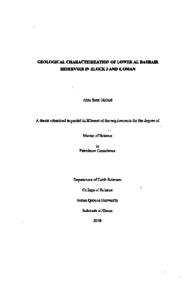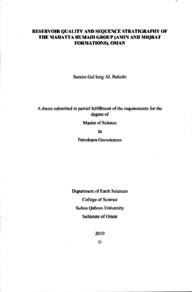Document
Geological characterization of lower Al Bashair reservoir in block 3 and 4, Oman
Publisher
Sultan Qaboos University
Gregorian
2018
Language
English
Subject
English abstract
The Late Cambrian Al Bashair Formation of Haima Şupergroup is distributed over north-central Oman subsurface. The extension of this formation is exposed at surface in a relatively small area named Qarn Mahatta Humaid, in the north of Huqf region. This formation was previously considered a seal for the underlying reservoirs of Haima Supergroup. However, recent explorations show successful and commercial production from the sandstone intervals of this formation in blocks 3 and 4 of Oman. Lithologically, Al Bashair Formation can be divided into Upper and Lower members. However, the Lower member comprises interbedded mudstone, sandstones and various types of carbonates whereas the upper member consists predominantly of mudstone interbeds with thin siltstone layers. This project aims to investigate reservoir potentiality and quality distribution of the Lower Al Bashair in the blocks 3 and 4. This study is based on (i) a detail description of two conventional cores for lithofacies determination, clarify the lateral and vertical continuity via correlation and depositional environment interpretation, (ii) the analysis of thirteen wells using Petrel and Techlog Schlumberger's software were used to identify lithology, detailed petrophysical interpretation (iii) textural and compositional analysis on thirty-three thin-sections collected from various lithofacies as well as diagenetic alterations distribution and their subsequent impact on reservoir quality evolution. A detail description of two conventional cores from two drilled wells in block 3 and 4 led into identification of eight distinct lithofacies namely (i) interbeds of sandstone/ siltstone with claystone, (ii) flaser sandstone bedding, (iii) lenticular mudstone bedding, (iv) claystone, (v) oolitic limestone, (vi) hummocky (vii) wavy rippled sandstone and sandstone to siltstone. The presence of oolitic limestones, hummocky cross stratification sandstones, wave rippled sandstones and bioturbations indicate that Lower Al Bashair Formation was deposited in shallow marine system. Conventional wireline logs collected from thirteen wells were used to identify lithology, petrophysical properties, lateral and vertical continuity of different reservoir intervals from the studied fields. Five types of electrofacies were identified, calibrated and compared with the constructed lithofacies from both conventional cores. The reservoir units of formation have been found to be laterally continuous in the three fields. The average limits for Lower Al Bashair Formation of volume of shale av. 34 %, porosity av. 13 %, permeability 3 mD and oil saturation av. 51 % where the highest reservoir quality found in Farah South Fields. The investigation of thin sections under optical microscope has shown that mechanical and chemical compaction of grains together with various types of cementation played major roles in porosity deterioration. Dolomite and calcite and anhydrate cements are significant in porosity reduction. The porosity enhancement is attributed mainly to partial dissolution of dolomite cement and thus development of intergranular secondary porosity. Integration of wireline logging and conventional core data helped in increasing our ability for better understanding of Lower Al Bashair Formation depositional environment and diagenetic alterations, reservoir quality distribution and continuity.
Description
Thesis
Member of
Resource URL
Arabic abstract
تكوين البشائر التي تعود للعصر الكمبري المتأخر، و تنتمي إلى مجموعة هيما الكبری، توجد في باطن الأرض من شمال سلطنة عمان. يبرر امتدادا لهذا التكوين علي سطح الأرض في منطقة تسمي قرن محطة حميد شمال منطقة الحق في تكوين البشائر كان يعتبر كطبقة حافظة للخزانات النفطية التي تحتها المنتمية المجموعة هيما. مؤخرا، أظهرت الإستكشافات الحديثة نجاحا في إنتاج المنتجات النفطية من الطبقات الرميله السفلية في تكوين البشائر في منطاق الإمتياز 3 و4 في عمان وبكميات تجارية. يقسم هذا التكوين من خلال الطباق الصخري إلى طبقتين، طبقة سفلية وطبقة علوية، تحتوي الطبقة السفلي على تناوب من طبقات الحجر الوحلي، والحجر الرملي و انواع مختلفة من الأحجار الجيرية واما الطبقة العليا فتتكون غالبا من الحجر الوحلي. يهدف هذا المشروع إلى التحقق من كفاءة الخزان و مدى انتشار الجودة للطبقة السفلي من هذا التكوين في منطقة الامتياز 3و4 في هذه الرسالة تم استخدام (1) عينتان جوفيتان من بئرين مختلفين لإيجاد التصنيف الطباقي الصخري امتداد الأفقي والعمودية الطبقات السفلية التكوين من خلال الربط بين الأبار المحفورة و إيجاد بيئة الترسيب (2) دراسة 13 بئر باستخدام برنامجين لشركة شلمبرجير (بترل والتك لوج) لإيجاد الطباقات الصخرية، والتحليل التفصيلي للخواص البتروفيزيائية (3) التحليل النسيجي و التكويني لثلاثة وثلاثين شريحة جمعت من مختلف السحنات لإيجاد التغيرات الناتجية عن العملية اللاحقة وكيفية توزيعها و تأثيرها على جودة الخزان أدي الوصف التفصيلي لعينتين المحفورتين من بئرين في مناطق الامتياز 3 و4 إلى تحديد ثماني سنحنات متميزة وهي: (1) تناوب طباقي من الحجر الرملي والحجر الغريني الرملي مع الطين، (2) طباق عدسي من الحجر الرملي، (3) طباق عدسي من الحجر الطيني (4) رقاق متوازية من الحجر الرملي (5) الحجر السرئي، (6) الحجر الرملي ذو تضاريس روابية (7) الحجر الرملي ينيم الموج (8) الحجر الرملي إلى الغرين الرملي المتغاير. ويشير وجود الحجر المرئي، والحجر الرملي ذو التضاريس الروابية و ونيم البحر، وتواجد البنيات الاضطرابية الأحيائية إلى أن تكوين البشائر قد تكون في بيئة روسوبية ضحلة الذي تهيمن عليه الأمواج أستخدمت الخطوط السلكية المأخوذة من 33 بئر محفور لإيجاد الطباق الصخري و الخواص الفيزيائية الصخور والامتداد الأفقي العمودي لطباقات الخزانات من الحقول المستهدفة من هذه الدراسة. خمسة أنواع من السحنات الكترونيا وجدت ثم قورنت بالسنحات المستخلصة من العينات الجوفية، و وجدت طبقات الرملية من الخزان لهذا التكوين ممتدة أفقيا في حقول الثلاثة الناتجة من هذه الدراسة أن متوسط حجم الطين الصخري 34 % المسامية 13 % و النفاذية 3 ملي دارسي و بتشبع نفطي 51 % لطبقات الرملية السفلى لهذا التكوين و حيث وجدت أعلى جودة للخزان بحقل فرح جنوبي وقد أظهرت دراسة الشرائح المجهرية تحت المجهر الضوئي أن العملية اللاحقة أدت إلى زيادة الاندماج الميكانيكي والكيميائي للجزئيات بالإضافة إلى بعض من أنواع مختلفة من اللحام لعبت أدوار رئيسية في انخفاض على المسامية في الجزء السفلي من التكوين، ويعتبر لحام الدلوميت والكالسيت والأنهيدرات من اهم اللحامات المجودة التي أثرت في خفض المسامية. ولكن يعزي زيادة المسامية بشكل أساسي إلى حل جزئي لحام الدولومیت وبالتالى وجود المتنامية الثانوية بين الحبيبات.وساعد تكامل قطع الخطوط السلكية والعينات المحفورة في زيادة قدرتنا على فهم أفضل لبيئة ترسب البشاير السفلي والتغييرات المابعدية، وتوزيعها نوعية الخزان ومدى انتشارها و امتدادها.
Category
Theses and Dissertations







